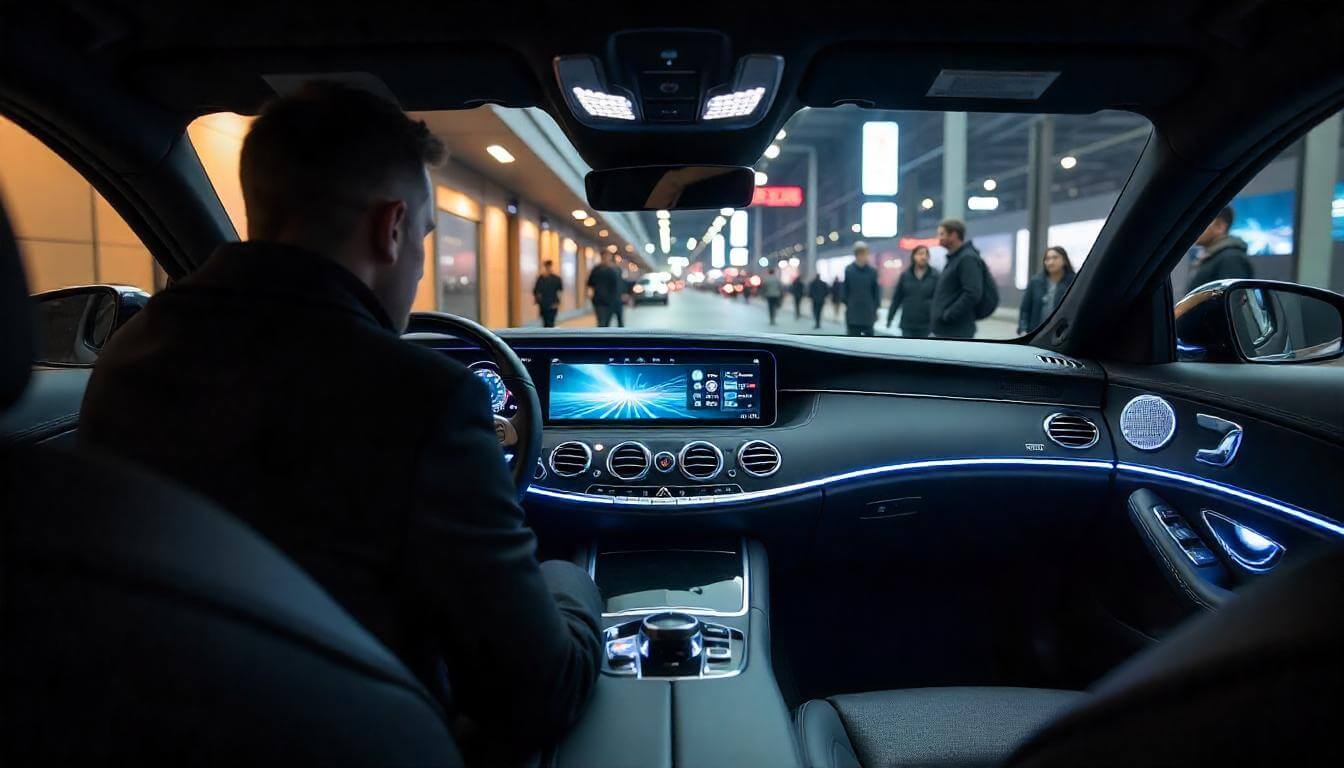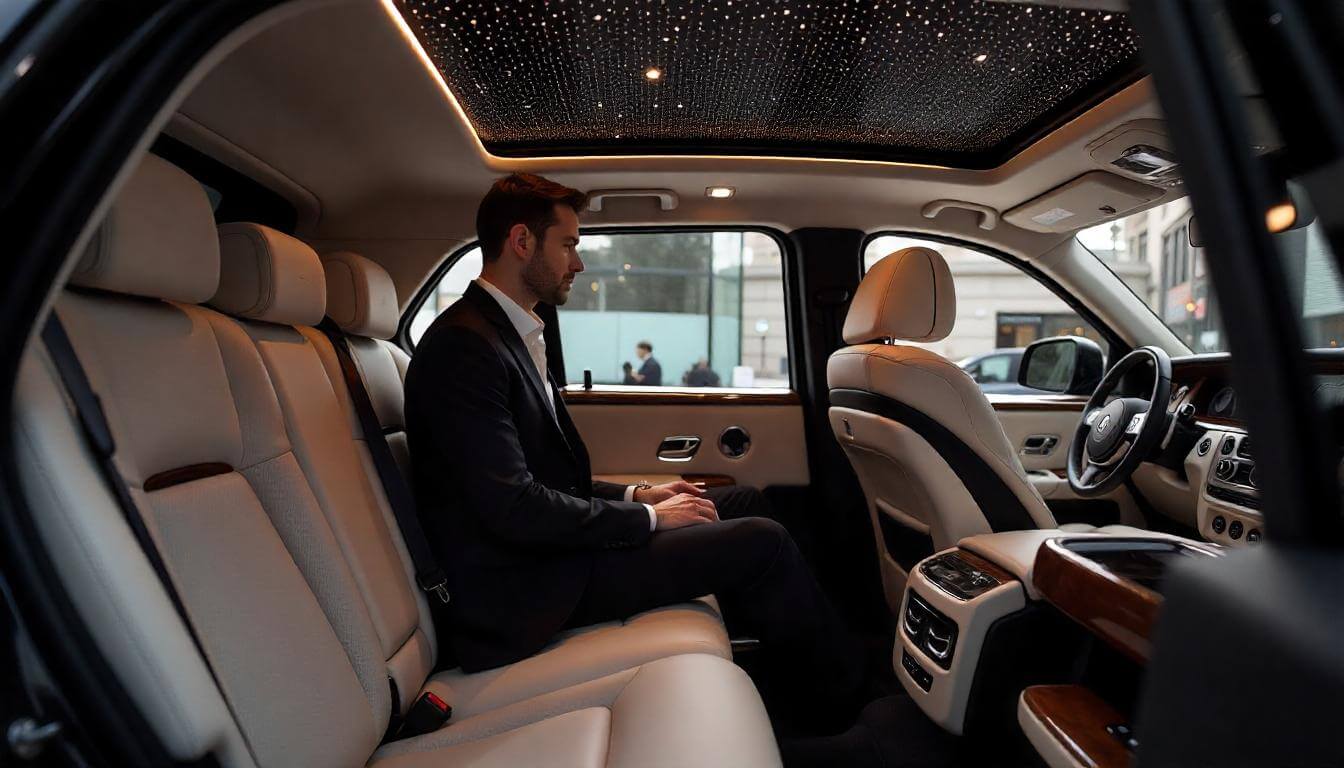Premium car interiors in 2025 are a combination of art, technology and luxury, making every journey a pleasure. Brands such as Rolls-Royce, Bentley and Mercedes-Benz are creating salons where comfort and style reach new heights. For example, the Rolls-Royce Phantom offers a star ceiling and the Mercedes-Benz S-Class equips the cabin with aromatisation. In this article, we'll look at how the interior design of premium cars shapes the driving experience, what materials and technologies are used, and what the future holds. Let's dive into the world of luxury saloons.
History: the first interiors of premium cars
The interiors of premium cars began to take shape in the early 20th century. For example, the 1907 Rolls-Royce Silver Ghost used wood panelling. Its interior cost $2,000 of the $12,000 total price. Also, the 1929 Duesenberg Model J added leather seats. The car cost $8,500. In addition, the 1924 Bugatti Type 35 used aluminium inserts. This emphasised status. Thus, the early saloons combined functionality and aesthetics.
The role of materials in early salons
Manufacturers chose expensive materials. For example, the 1915 Cadillac Type 53 used mahogany. Hand-tooled leather was also standard. In addition, chrome parts added lustre. For example, the 1930 Mercedes-Benz 770 had silver accents. Also, the seats were sewn by hand. Therefore, the early interiors were works of art. They set the tone for future designs.
The Golden Age: luxury car saloons of the 1950s-1960s
In the mid-twentieth century, the interiors of luxury cars became more luxurious. For example, the 1955 Rolls-Royce Silver Cloud used woollen carpets. Its price was $13,000. Also, the 1955 Mercedes-Benz 300SL Gullwing added leather seats with stitching. The car was priced at $11,000. In addition, the 1952 Bentley R-Type Continental applied walnut panelling. Thus, this period became a landmark period for the design.
Elements of the Golden Age style
Designers experimented. For example, the 1963 Aston Martin DB5 used chrome switches. Also, the 1961 Jaguar E-Type added a wooden steering wheel. In addition, the 1962 Ferrari 250 GTO applied a minimalist style. Its interior was race-oriented. Also, seats with side support became popular. Therefore, the saloons combined elegance and practicality.
Modernity: premium car interiors in the twenty-first century
Premium car interiors have reached new heights in the 21st century. For example, the 2025 Rolls-Royce Phantom offers a ceiling with stars. Its interior costs $50,000 of the $500,000 total price. Also, the 2025 Bentley Bentayga uses 22 seat adjustments. The car costs $166,000. In addition, the Mercedes-Benz S-Class equips the interior with a Hyperscreen. It is a 141cm screen. Thus, modern saloons are all about technology and luxury.
Technology in modern salons
Technology plays a key role. For example, the 2023 BMW i7 has a 31-inch screen for rear passengers. The Porsche Taycan also uses a projection display. It shows data on the glass. In addition, the Audi Q8 applies a voice assistant. It controls the climate. Also, the Rolls-Royce Cullinan offers Wi-Fi. Therefore, the saloons have become digital spaces.
Materials: interior style of luxury cars
Materials define style. For example, the Bentley Flying Spur uses hand-sewn leather. The Rolls-Royce Spectre also uses recycled aluminium. This emphasises the ecology. In addition, the Mercedes-Benz EQS uses vegan leather. It reduces the carbon footprint. Also, the Lamborghini Aventador adds carbon fibre inserts. Therefore, the materials create a unique atmosphere.
Eco-friendly solutions in salons
The environment influences choices. For example, the BMW i7 uses recycled plastic. The mats are made from bottles. The Audi e-tron GT also uses eco-friendly paints. They reduce emissions. In addition, the Bentley Bentayga uses vegan leather. This reduces the harm to nature. Also, the Rolls-Royce Spectre uses recycled materials. This makes the saloons more sustainable.
Comfort: comfort in the saloons of expensive cars
Comfort is a priority in the premium segment. For example, the Rolls-Royce Phantom offers seats with massage. Also, its noise insulation reduces noise by 10 decibels. In addition, the Mercedes-Benz S-Class equips the cabin with aromatisation. The driver chooses from six flavours. Also Bentley Bentayga has heated armrests. So every journey becomes a pleasure.
Technology for passengers
Manufacturers care about passengers. For example, the BMW 7-Series offers a 31-inch screen. It folds into the ceiling. Also, the Porsche Panamera has ventilated seats. In addition, the Audi A8 uses adaptive climate control. It adjusts the temperature. Also the Rolls-Royce Cullinan adds heated steering wheel. Thus, comfort reaches a new level.

Personalisation: interior design of premium cars
Personalisation makes saloons unique. For example, Rolls-Royce offers 44,000 shades of leather. Bentley Flying Spur also adds embroidered initials. In addition, Ferrari Roma allows you to choose the carbon fibre texture. Porsche Exclusive Manufaktur also creates customised details. For example, engraved wooden inserts. The saloons therefore reflect the owner's taste.
Individuality in the details
Details create style. For example, the Bugatti Chiron uses engraved panels. Also, the Rolls-Royce Boat Tail adds a handmade clock. In addition, the Lamborghini Aventador offers seats with stitching. The customer chooses the colour of the threads. Also the Mercedes-Benz S-Class allows customisation of the lighting. Therefore, personalisation makes the saloons unique.
Technology: the inner style of luxury cars
Technology is changing saloons. The Mercedes-Benz EQS, for example, uses the Hyperscreen. The screen controls all functions. The BMW i7 also uses a projection display. It shows navigation. In addition, the Porsche Taycan uses 5G for communication. It provides fast internet. Also the Rolls-Royce Cullinan offers Bang & Olufsen acoustics. Therefore, technology makes the saloons smarter.
Digitalisation of salons
Digitalisation plays a role. For example, the Audi e-tron GT supports Apple CarPlay. Also, the Tesla Model S Plaid uses a 17-inch screen. It replaces the buttons. In addition, the Bentley Bentayga adds a voice assistant. It controls the multimedia. Also, the Bugatti Chiron has inbuilt navigation. Thus, the saloons become digital.
Aesthetics: premium car interiors
Aesthetics is an important aspect. For example, the Rolls-Royce Phantom uses a ceiling with stars. This creates the effect of the sky. The Bentley Flying Spur also uses walnut panelling. They add warmth. In addition, the Mercedes-Benz S-Class uses ambient lighting. It changes colours. Also, the Lamborghini Aventador adds carbon fibre accents. So the interiors look like works of art.
Balance of style and functionality
Designers find a balance. The Porsche 911 GT3, for example, uses a sporty style. Its seats support the body. The Audi Q8 also uses minimalism. It makes the interior more spacious. In addition, Ferrari SF90 Stradale adds bright accents. They emphasise the dynamics. Also Rolls-Royce Spectre uses glass inserts. Thus, aesthetics is combined with practicality.
The future: luxury car showrooms
The future promises innovation. For example, Rolls-Royce is planning holographic displays. Mercedes-Benz is also testing adaptive seats. They change shape. BMW is also developing AI for saloons. It will anticipate desires. Bentley is also planning to use 3D printing. So the saloons will become even smarter.
Trends on the horizon
New trends are shaping the future. For example, holographic elements will appear in the interior. Also, adaptive materials will change texture. In addition, virtual reality will make it possible to test salons. Also eco-friendly materials will become the standard. Therefore, the future of salons will be technological.
Conclusion: premium car interiors as art
Premium car interiors are an art form where comfort, style and technology merge. They make travelling a pleasure. For example, the Rolls-Royce Phantom creates a cosy atmosphere. The Mercedes-Benz S-Class also impresses with its technology. In addition, saloons are becoming more environmentally friendly and smarter. Therefore, luxury cars continue to set standards, inspiring new heights.

 Premium car interiors: the art of comfort and style">
Premium car interiors: the art of comfort and style">
